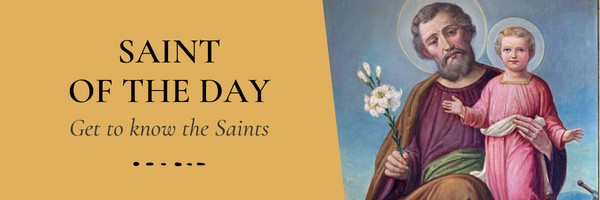 Dear readers, Catholic Online was de-platformed by Shopify for our pro-life beliefs. They shut down our Catholic Online, Catholic Online School, Prayer Candles, and Catholic Online Learning Resources essential faith tools serving over 1.4 million students and millions of families worldwide. Our founders, now in their 70's, just gave their entire life savings to protect this mission. But fewer than 2% of readers donate. If everyone gave just $5, the cost of a coffee, we could rebuild stronger and keep Catholic education free for all. Stand with us in faith. Thank you. Help Now >
Dear readers, Catholic Online was de-platformed by Shopify for our pro-life beliefs. They shut down our Catholic Online, Catholic Online School, Prayer Candles, and Catholic Online Learning Resources essential faith tools serving over 1.4 million students and millions of families worldwide. Our founders, now in their 70's, just gave their entire life savings to protect this mission. But fewer than 2% of readers donate. If everyone gave just $5, the cost of a coffee, we could rebuild stronger and keep Catholic education free for all. Stand with us in faith. Thank you. Help Now >
The Carthusian Order
FREE Catholic Classes
The name is derived from the French chartreuse through the Latin cartusia , of which the English "charterhouse" is a corruption. For the foundation of the order see the article SAINT BRUNO. The following points will be considered here:
I. The Rule;II. Life of the Monks ;
III. Organization;
IV. Development;
V. Present State of the Order;
VI. Distinguished Carthusians;
VII. English Province;
VIII. Carthusian Nuns.
I. THE RULE
We have two accounts of the manner of life of the first Carthusians, the earliest, written by Guibert, Abbot of Nogent, the second by Peter the Venerable, Abbot of Cluny. The former runs as follows: "The church stands upon a ridge . . . thirteen monks dwell there, who have a sufficiently convenient cloister, in accordance with the cenobitic custom, but do not live together claustraliter like other monks. Each has his own cell round the cloister, and in these they work, sleep, and eat. On Sundays they receive the necessary bread and vegetables (for the week) which is their only kind of food and is cooked byy each one in his own cell; water for drinking and for other purposes is supplied by a conduit . . . . There are no gold or silver ornaments in their church, except a silver chalice. They do not go to the church as we do [Guibert was a Benedictine ], but only for certain of them. They hear Mass, unless I am mistaken, on Sundays and solemnities. They hardly ever speak, and, if they want anything, ask for it by a sign. If they ever drink wine, it is so watered down as to be scarcely better than plain water. They wear a bair shirt next the skin, and their other garments are thin and scanty. They live under a prior, and the Bishop of Grenoble acts as their abbot and provisor . . . Lower down the mountain there is a building containing over twenty most faithful lay brothers [ laicos ], who work for them. . . . Althougli they observe the utmost poverty, they are getting together a very rich library. (P.L., CLVI, 853 sqq.).
Peter the Venerable adds certain details, lays stress on the poorness of their garments, and mentions that they restricted their possessions both in land and cattle, and fixed their own number at thirteen monks, eighteen lay brothers, and a few servants. Of their diet he says, "They always abstain from the eating of meat, whether in health or ill. They never buy fish, but accept them if given in charity. Cheese an eggs are allowed on Sundays and Thursdays. On Tuesdays and Saturdays, they eat cooked vegetables, but on Mondays, Wednesdays and Fridays, they take only bread and water. They eat once a day only, save at Christmas, Easter, Pentecost, Epiphany, and on certain other festivals . . . . On feast days they go to the refectory, eat twice, and sing the whole office in the church." (P.L., (CLXXXIX, 944 D.)
Guibert wrote in 1104, Peter some twenty years later, so there was time for development, which may account for certain discrepancies between the two accounts. The "Customsi" of the Chartreuse were not committed to writing till 1127. Bruno had left the world in order to serve God in solitude, and without any intention of founding an order. In the earliest days the hermits had no rule, but all strove to live after Bruno's example and in accordance with the Evangelical counsels. When regular monastic buildings were erected and vocations began to increase, some sort of rule became a necessity. St. Bruno wrote none, but the customs which he introduced, together with additions born of experience, were embodied in the "Consuetudines" written by Guigo, the fifth prior, in 1127. This was not a rule written with authority, but a record of the usages of the motherhouse of the order (Ann., 1, 305), compiled at the request of the priors of the charterhouses, and finally accepted by them as their code. In the introduction the writer says that almost all the customs are contained "either in the epistles of the Blessed Jerome, or in the Rule of St. Benedict , or in other authorized writings". A later writer, Boso, the nineteenth prior of the Grande Chartreuse (d. 1313), says, "It is clear that the contents of the Statutes come either from St. Benediet's Rule, St. Jerome's Epistles, the 'Vitae Patrum' or the 'collationes' and other writings of Cassian and the Fathers" (quoted in Ann., 1, 37). The Rule of St. Benedict (the only monastic rule of those days) gave the norm of those duties which were performed in common, and supplied the arrangement of the Divine Office, the treatment of guests, the form of the vows. Many new departures were introduced to meet the needs of the solitude which is an essential of the Carthusian life; from the Fathers of the Desert came the laura-like arrangement of the building and the solitary life of the cells, while the statutes are probably also indebted to the Rule of Camaldoli (see CAMALDOLESE) (founded by St. Romuald in 1012), which was reduced to writing by the Blessed Rudolf in 1080. The fundamental principle of Camaldoli and the Chartreuse is the same, namely, the combination of Western monasticism as embodied in St. Benedict's Rule with the eremitical life of the Egyptian solitaries. In both orders the superiors were to be priors, not abbots, and in all the earliest Carthusian houses there was, as at Camaldoli, a "lower house" for lay brothers who served the external needs of the contemplative monks at the "upper house". The first hermits tended strongly to be purely eremitical, but the cenobitic development was hastened hour by the necessities of life find by the influence of neigbouring Benedictine houses, especially perhaps of Cluny. The union of the two systems was only gradually evolved under the pressure of circumstance.
Guigo's "Consuetudines" were first approved by Innocent II in 1133 (Ann., I, 305) and are still the basis of the modern statutes. In 1258 the general, Dom Riffier, issued a new edition, adding various ordinances passed by the general chapters since 1127; these are known as the "Statuta Antiqua". The "Statuta Nova" with similar additions appeared in 1368. In 1509 the general chapter approved the "Tertia Compilatio", consisting of a collection of the ordinances of the chapters and a synopsis of the statutes. The Carthusian Rule was printed for the first time by Johann Amorbach at Basle in 1510. This volume contains Guigo's "Consuetudines", the "Statuta Antiqua", the "Statuta Nova", and the "Tertia Compilatio". The "Nova Collectio Statutorum" was published in 1581. This work, which had cost eleven years of preparatory labour, includes in one well-ordered series all the various legislation scattered throughout the cumbersome volume of 1510. A century later a second edition was printed at the Correrie or "lower house" of the Grande Chartreuse by order of Dom Innocent Le Masson, and this, after receiving certain corrections of slight importance, was finally confirmed by Innocent XI by the Bull "Injunctum nobis" of 1588. The fifth edition of the statutes is a verbal reprint of the second. The first part, or "Ordinarium", which is printed separately, is concerned with church ceremonial, the second treats of the government of the order and the observances and occupation of the religious, the third is concerned with the lay brothers and the nuns. Guigo's "Consuetudines" contains in substance the customs introduced by St. Bruno with certain additions and modifications. The many formal changes and accretions which the original "Consuetudines" have undergone, have affected neither their substance nor their spirit, but, as Le Masson says, "have been like a change of clothing, which adds nothing and takes nothing from the substance of the body" (Discip. Ord. Cart., 1, vii, 9). We must remember that the pictures given by Guibert and Peter the Venerable depict the Carthusian life at a stage of semi-development. The only mitigation of importance introduced since Guigo's day is the decrease of the fast on bread and water from thrice to once weekly. Additional duties have been laid upon the monks in the shape of extra prayers, the singing of a daily conventual Mass, the lengthening of the night Office and of the Office for the Dead, and the withdrawal of the permission to take a midday siesta, while, instead of having, as formerly, seven or eight hours uninterrupted sleep, their rest is now broken by the long night vigils (P. L., CLTII, 609A).
II. LIFE OF THE MONKS
A Carthusian monastery covers a great deal of ground owing to the system of life. It usually consists, of the great cloister, round which are the separate houses, or "cells" of the monks, the lesser cloister with cells of various officials, the "obediences", or workshops of the lay brothers and their living rooms, church, chapter-house, refectory and other conventual offices. The church is usually small and without aisles, divided by a solid screen with a door and two altars into the choir proper and lay brothers ' choir. No organ is allowed. There is usually a tribune for visitors. No woman, save the sovereign, may enter a charterhouse. At the side of each cell door is the guichet or hatch, through which the monk's food is introduced by a lay brother ; within, a covered ambulacrum , with a small garden beside it, leads to the house. This consists of five rooms; on the ground floor, a store room for timber and fuel, and a workshop with a lathe and other tools; above, an antechamber, a small library with just sufficient room for bookcase, chair, table, and the cell proper, whose furniture consists of a wooden box-bedstead with woollen blankets, and mattress of straw, a table for meals, a few chairs, a stove, and a stall with a prie-Dieu , known as the oratorium .
The Carthusian life is essentially solitary and contemplative with a certain admixture of the cenobitic element (see I). A very large part of the day is devoted to saying the three Offices (i.e. that of the day, the Office of Our Lady, which is called de Beata , and the Office of the Dead ), while much time is given to mental prayer. The rest is divided between manual labour, study, and a little recreation. The whole horarium depends on whether the Office of the day be that of the feria or of a Sunday or feast. The following is the ferial arrangement, which is by far the commoner. The Carthusian's day begins at half-past five, when a junior monk, going the round of the cloister, rings a bell hanging near the sleeper's ear. The church bell rings at six, when Prime of the day is said in the oratorium, followed by Terce de Beata . All offices said in the oratorium are accompanied by full choir ceremonial, as bowing, covering, and uncovering. At half-past six the Angelus sounds, and the monk remains at prayer till a quarter to seven, when he goes to the church. The conventual Mass, which is always sung, is preceded by adoration of the Blessed Sacrament and the litanies of the saints. The Carthusian liturgy differs considerably from the Roman Rite, being substantially that of Grenoble in the twelfth century with some admixture from other sources. There are no servers at the high Mass, and the priest is attended by the deacon, who wears neither alb nor dalmatic, but the cuculla ecclesiastics (see below) and, for the Gospel only, a stole. The subdeacon merely reads the Epistle at the lectern in the middle of the choir. There are many other points of difference. Copes and monstrances are unknown in the charterhouse. After the conventual Mass the priests say their private Masses, reciting Terce with the server before vesting and Sext de Beata after their thanksgiving.
At about half-past eight the monk returns to his cell and is occupied with manual work and meditation till ten, when, after saying Sext of the day, he fetches his dinner from the guichet . The meal is copious and excellently cooked, consisting of vegetable soup, fish or eggs, vegetables, cheese, butter and fruit, and a small bottle of wine or, in England, of rather thin beer. After dinner there is an hour and a half of solitary recreation, which may be spent in garden, ambulacrum, or cell at will, and is followed by None ; spiritual reading, study, and manual labour till half-past two, when Vespers de Beata are said. At a quarter to three the monk leaves his cell for the second time, going to the church to sing Vespers, and, except on feasts and their vigils, Vespers and Matins of the Dead. He returns to his cell about four, and, after half an hour's study, takes his supper, consisting generally of eggs and a little salad. This is followed by spiritual reading and examination of conscience , known in the order as the "recollection". At a quarter to six, but earlier on the eve of a feast, the bell sounds for Complin of the day and de Beata . At about half-past six the monk retires to bed, still wearing the greater part of his habit. Five hours after the Complin bell, he rises and says Matins and Lauds de Beata with the Psalm "Deus venerunt gentes" and certain prayers for the recovery of the Holy Land. These last were ordered to be said during Mass by the Lateran Council in 1215, and were retained voluntarily bv the Carthusians after the law ceased to bind, but transferred to this hour. At a quarter to twelve the monk leaves his cell for the third and last time to sing Matins and Lauds with Lauds of the Dead. This takes two and a half to three hours. To a visitor it is very impressive. A large portion of the Office is sung in complete darkness save for the sanctuary lamps, the rest by the light of small oil lamps carefully shaded to throw their light only one the choir books, one of which is provided for every three religious. The Carthusian chant, a species of Gregorian, has a special character of its own, slow and plaintive. "As the duty of a good monk is rather to lament than to sing", say the rubrics, "we must so sing that lamentation, not the joy of singing, be in our hearts." At about a quarter past two in the morning the Carthusian returns to his cell, where he says Prime de Beata . His total of sleep, thus broken into two parts, is seldom less than seven hours. On Sundays and feast days this horarium is considerably modified. The community assemble for all the Hours of the Great Office in church, and in the refectory for both meals. These latter are always eaten in silence, while the Scripture or some homily of the Fathers is chanted to the solemn tones of the nocturn-lessons. On these days also there is a common recreation with talking in the cloister for the solemnly professed, but only on Sundays for all. Once every week, the monks go out for a walk together, during which they converse. This is known as the Spatiamentum and usually lasts about three and a half hours.
During the great monastic fast, which lasts from 14 September to Ash Wednesday, except for Sundays and feast days, dinner is an hour later, and supper consists of a glass of wine and a crust of bread ne potus noceat (Statutes). During Lent, Vespers are sung before dinner, which is not till midday and supper is as above. Meat is never allowed on any account, though, in a case of life and death, the monk may, if not solemnly professed, be dispensed. Once a week there is a fast on bread and water and during Advent and Lent, on Fridays and on certain vigils lacticinia are forbidden.
The Carthusian wears the ordinary monastic habit in white serge, but the scapular which is joined by bands at the side and has the hood attached to it, is known as the "cowl". The long flowing garment with wide sleeves, which usually bears this name, is used only by the deacon at high Mass. No beard is worn, and the hair is shaved except for a narrow strip round the head. Novices wear a black mantle and their cowl is short and unjoined. The postulancy usually lasts one month, the novitiate one year, at the end which simple vows are taken; the solemn vows are taken four years later.
The lay brothers live an entirely cenobitical life, and are occupied in the servile work of the establishment. Their habit differs only slightly from that of the fathers. After two years postulancy and novitiate, the lay novice becomes a donné , wearing a brown habit, but takes no vows. He may remain always in this condition, but it requires eight more years to become a solemnly professed lay brother. The lay brothers and donnés , collectively known as the Familia , are under the procurator, and have their own chapel, chapter-house, and refectory. Their Office consists of a large number of Paters and Aves. They attend the night Office, conventual Mass, and Vespers, on Sundays and feasts, but usually only the first part of the night Office.
III. ORGANIZATION
The prior of the Grande Chartreuse, who is elected by the monks of that house, is always the general of the order. He wears no insignia, but is the only one in the order who receives the title of "Reverend Father", all other religious being known as "Venerable Fathers". The general chapter, which consists of the visitors and all the priors, meets annually, and receives the resignations of all the superiors of the order including the general. These it reinstates or removes at will. Its ordinances have the force of law, but do not become permanent unless twice renewed. The visitors, who are appointed by the chapter, make a visitation of each charterhouse every two vears, to enquire into its condition and reform any abuses. The first general chapter of the order was held by St. Anthelm in 1142, and in the year 1258 its powers were confirmed by Pope Alexander IV . To the wise ordinances of this body and to its series of distinguished generals the order owes its claim nunquam reformata quia nunquam deformata .
The prior of each house is, in strict law, elected by the professed monks of the community, if there are four present who have been actually professed for that house or who are original founders. Nowadays he is generally the father general and the chapter. The prior is assisted by various officials. These are the vicar, who takes the prior's place in case of necessity, the procurator, who is entrusted with the temporal administration and the care of the lay brothers, the coadjutor, who looks after guests and retreatants, the antiquior, who takes the vicar's place, the sacristan, and the novice-master.
IV. DEVELOPMENT
From its very nature the order grew slowly. In 1300 there were but 39 monasteries, but during the fourteenth century 113 were founded, extending as ftr as Silesia, Bobemia, and Hungary. During the Great Schism there were two generals, but both resigned on the election of Alexander V in 1409 and the order was once more united. During the fifteenth century, 44 charterhouses were founded and in 1521 there were in all 206, but during the sixteenth century 39 were destroyed b the Reformation and only l3 founded. In 1559 a foundation in Mexico was projected but fell through owing to the opposition of the King of Spain. Writing in 1607 Le Masson says, "We number about 2,500 choir monks and 1,300 lay brothers and donnés , giving an average of a dozen fathers and eight or nine lay brothers to each house". Between 1600 and 1667, 22 monasteries were founded, and then no more till the nineteenth century. The order entirely escaped the scourge of commendatory superiors. Joseph II suppressed 24 houses, and in 1784 the Spanish Government compelled its charterhouses to separate from the order.
The French charterhouses were less infected with Jansenism than most of the ancient orders. Owing to the energy of the general, Dom Antoine de Mongeffond, only thirty monks out of a total of over 1,000, and those mostly belonging to the Paris house, ultimately refused to sign the "Unigenitus". These fled to Utrecht. At the outbreak of the Revolution there were 122 charterhouses, which were nearly all suppressed, as the French armies swept over Europe. In 1816 the monks returned to the Grande Chartreuse. The Spanish houses were suppressed in 1835; the Port-Dietu in Switzerland, which had escaped the earlier storm, in 1847; the monasteries in Italy for a second time during the course of the Risorgimento; and the restored French houses as a consequence of the Association Laws of 1901.
V. PRESENT STATE OF THE ORDER
In 1900 the monks possessed eleven monasteries in France and nine in other parts of Europe. The French houses are now empty and four new or restored houses have been opened in Spain and Italy. The following is a list of the charterhouses existing at the end of 1907. In Italy : Farneta, near Lucca, recently repurchased and occupied by the general and the conventus Cartusiae ; Pisa ; Florence, where the monks are merely custodians of a national monument; Trisulti, near Alatri ; La Torre, in Calabria; Vedana, in the Diocese of Belluno; La Cervara, near Genoa, recently repurchased. The Procura of the order at Rome. In Spain : Monte Allegro, near Barcelona; Aula Dei, Peñaflor, near Saragossa; Miraflores, with its spelendid royal tombs ; the liqueur is made at the Casa de los Cartujos, Tarragona. In England : Parkminster, in Sussex, is the largest charterliouse in the world, with thirty-six cells and 3,166 feet of cloister. It now contains the community of Notre-Dame de Près, Montreuil, as well as its own. In Switzerland : Val-Sainte in Canton Friburg. In Gerimany: Hain near Düsseldorf. In Austria Pletterjack, founded in 1403, abandoned 1595, and since rebuilt. In Belgium : the printing works belonging to Montreuil are now at Tournai. There are 300 solemnly professed monks, 35 junior professed, and 15 novices, making 350 choir monks, of whom about 20 are not yet priests ; also about the same total of lay brothers , lay novices, and donnés . The badge of the order is a globe surronded by a cross and seven stars, with the motto "Stat crux, dum volvitur orbis".
The famous liqueur is a secret manufacture, invented by the monks in the nineteenth century, as a means of subsistence, to take the place of the broad acres lost in the Revolution. The large proceeds, after assisting to pay for the maintenance of the various charterhouses and the building of new ones, has been entirely devoted to various works of charity.
VI. DISTINGUISHED CARTHUSIANS
Besides St. Bruno the best known saints of the order are: St. Hugh, Bishop of Lincoln (d. 1200); St. Anthelm, seventh prior of the Grande Chartreuse, and first general, who died Bishop of Belley in 1178; St. Arthold, Bishop of Belley (d. 1206); St. Stephen of Chitillon, Bishop of Die (d. 1213). Many members have been beatified, among them the English Carthusian martyrs and Bl. Nicolo Albergati , Cardinal and Bishop of Bologna. There have been about seventy Carthusian bishops and archbishops, including a few cardinals. There has never been a Carthusian pope.
Guibert mentions the richness of the library of the chartreuse (see I), and in his "Consuetudines" Guigo writes, "We desire that books be looked after most carefully as the continual food of our souls, and that they be written [ fieri ] with the utmost diligence, so that we may preach the Word of God by the work of our hands, since we cannot do so with our mouths", and again, "we teach writing to almost all whom we receive" (P.L., CLIII, 693). Throughout the Middle Ages the Carthusians were famous copyists. St. Bruno himself was the first Carthusian author, writing commentaries on the Psalms and on St. Paul's Epistles (v. Löbbel, op. cit. infra , 179-241). He was followed by Guigo, who, besides the "Consuedines", wrote "Meditations" and a "Life of St. Hugh of Grenoble ". Writers of the order have mostly treated of ascetics and mvstical theology. The following are among the more famous: Ludolf of Saxony (d. after 1340), the author of a well known "Vita Christi"; Henry of Xalkar (d. 1408), who converted Gerhard Groot; Denis the Carthusian (d. 1471), the Doctor Ecstatims whose works are now being edited by the order in 45 vols.; Lanspergius (d., 1539); Surius (d. 1578), whose "Vitae" still form a useful supplement to the Bollandists' unfinished "Acta"; Nicholas Molin (d. 1638); Petreius (d. 1640); Innocent Le Masson (d. 1703); Le Couteulx (d. 1709); Tromby, who flourished c. 1783, all historians of the order. The first book printed at a charterhouse was issued from the presses of the Seliola Dei near Parma in 1477. The modern printing works of the order were transferred in 1901 from the chartreuse of Montreuil to Tournai.
VII. ENGLISH PROVINCE
The first English charterhouse was founded at Witham in Somerset by King Henry II in 1178, the tenth and last by Henry V in 1414 at Sheen. At the time of Henry VIII's breach with Rome the monks, especially those of the London charterhouse (founded 1370), offered a stanch resistance. The fourth of May, 1535, is memorable for the deaths of the Protomartyrs of the English Reformation, the Bridgettine Monk Richard Reynolds, and the three Carthusian Priors, John Houghton of London, Robert Lawrence of Beauvale, and Augustus Webster of Axholme. During the next five years, fifteen of the London Carthusians perished on the scaffold or were starved to death in Newgate Gaol. On Mary's accession nineteen monks belonging to various houses gathered at Sheen under Prior Maurice Chauncy, a monk of the London Charterhouse, who, to his lasting sorrow, had lost the crown of martyrdom by taking the Oath of Supremacy. The restoration was short-lived, for on Mary's death the monks were once more driven into exile. Prior Chauncy (died in 1581, but the English community kept together in different parts of the Low Countries with varying fortunes, until the charterhouse of Sheen Anglorum at Nieuport, with a community of six choir monks and two donnés , was suppressed by Joseph II in 1783. The last prior, Father Williams, died at Little Malvern Court, 2 June, 1797. His papers, the seal of Sheen Anglorum, and various relics are now in the possession of the Carthusians of Parkminster. A charterhouse was founded at Perth in 1429 by King James I of Scotland, and a short-lived foundation was made at Kinalehin in South Connaught in 1280, being abandoned by the order in 1321.
VIII. CARTHUSIAN NUNS
In the Priorship of St. Antheim, about 1245, the nuns of the ancient Abbey of Prébayon asked to be received into the order, and Blessed John of Spain, Prior of Montrieux, was ordered to adapt the Carthusian Rule to their needs. The nuns have never been numerous. Two convents were founded in the twelfth century, nine in the thirteenth, and four in the fourteenth, but of all these only nine were in existence in 1400. In 1690 when Innocent Le Masson published the "Statuts des Moniales" there were only five, four of which were in France and one near Bruges ; the last was suppressed by Joseph II in 1783, and the others disappeared in the French Revolution. In 1820 the surviving nuns reassembled at Lozier (Isere), and finally settled in 1822 at Beauregard, some miles from the Grande Chartreuse. Thence foundations were made in 1854 at Bastide-Saint-Pierre (Tarn-et-Garonne), and in 1870 at Notre-Dame du Gard near Amiens. The nuns are still at Beauregard, but the rest are in exile at Burdine in Belgium, and at San Francesco, and Motta Grossa near Turin. The total number of nuns is about 140, of whom 90 are " consecrated ".
The Carthusian nuns have always been famed for their regularity and fervour. Convents which had become lax were cut off from the order by the general chapter. The small number of convents is explained not only by the severity of the rule, but also by the great reluctance to accept new houses always displayed by the order. In 1368 the acceptance of new houses was forbidden by the general chapter , and this prohibition was frequently reiterated. The life of the nuns is very similar to that of the monks, with certain exceptions. They have single rooms instead of separate dwellings, two recreations every day, eat together daily, are not bound to wear the cilicium , and if ill are cared for in an infirmary. They are allowed eight hours sleep. Eleven hours daily are given to prayer and meditation, as well as work for the poor or for the church. The arrangement of their Office is practically that of the monks. Perpetual enclosure has been practised since the thirteenth century, and visitors are only received at a grille and in the presence of another nun. Each convent is divided into two distinct parts:
- the monastery proper with the cells and conventual offices;
- the dwelling of the two monks, who are known as the vicar and the coadjutor. These two direct the nuns and have two or three lay brothers to serve them. The two fathers live exactly as if in a charterhouse, attending Office in stalls placed in the sanctuary of the church, which is divided from the nuns' choir by a curtained grille.
The habit is the same as that of the monks, with the exception of the hood, for which a veil is substituted -- white for the young religious, and black for the " consecrated " nuns. According to the statutes the vows should be solemn, but since the Revolution they have been regarded as simple by the Church. No widow is received. The Carthusian nuns have retained the privilege of the consecration of virgins, which they have inherited from the nuns of Prébayon. The consecration, which is given four years after the vows are taken, can only be conferred by the diocesan. The rite differs but slightly from that given in the "Pontifical". The nun is invested with a crown, ring, stole and maniple, the last being worn on the right arm. These ornaments the nun only wears again on the day of her monastic jubilee, and after her death on her bier. It is a consecrated nun who sings the Epistle at the conventual Mass, though without wearing the manible. At Matins, if no priest be present, a nun assumes the stole and reads the Gospel. There are also lay sisters, Données , and Saeurs Touricres . Famous among Carthusian nuns have been St. Roseline of Villeneuve and Bl. Beatrix of Ornacieus.
Join the Movement
When you sign up below, you don't just join an email list - you're joining an entire movement for Free world class Catholic education.
An Urgent Message from Sister Sara – Please Watch
- Advent / Christmas
- 7 Morning Prayers
- Mysteries of the Rosary
- Litany of the Bl. Virgin Mary
- Popular Saints
- Popular Prayers
- Female Saints
- Saint Feast Days by Month
- Stations of the Cross
- St. Francis of Assisi
- St. Michael the Archangel
- The Apostles' Creed
- Unfailing Prayer to St. Anthony
- Pray the Rosary
![]()
Copyright 2025 Catholic Online. All materials contained on this site, whether written, audible or visual are the exclusive property of Catholic Online and are protected under U.S. and International copyright laws, © Copyright 2025 Catholic Online. Any unauthorized use, without prior written consent of Catholic Online is strictly forbidden and prohibited.
Catholic Online is a Project of Your Catholic Voice Foundation, a Not-for-Profit Corporation. Your Catholic Voice Foundation has been granted a recognition of tax exemption under Section 501(c)(3) of the Internal Revenue Code. Federal Tax Identification Number: 81-0596847. Your gift is tax-deductible as allowed by law.













